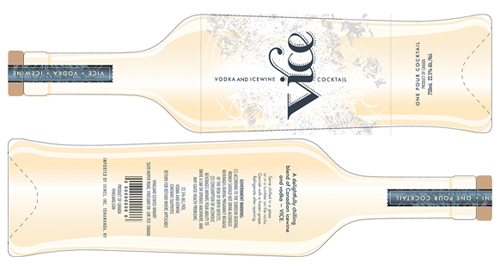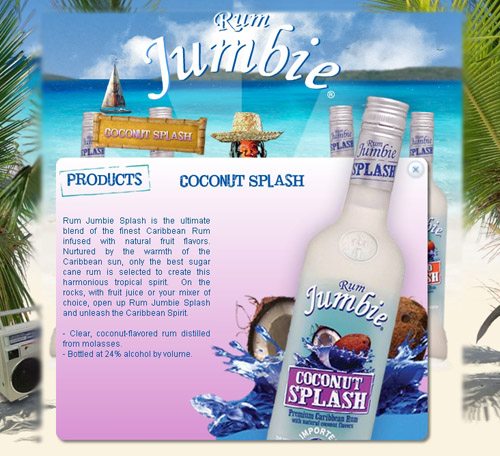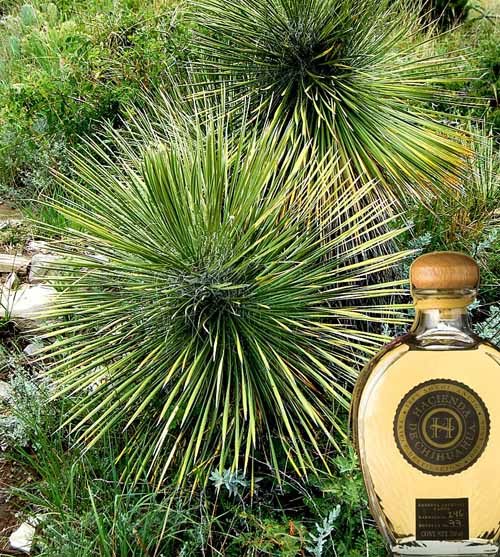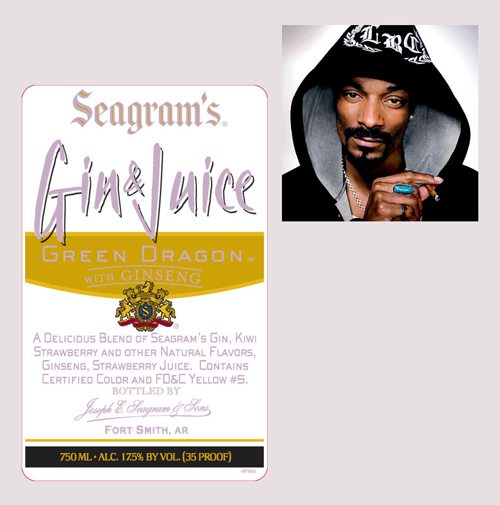Calvin knows a thing or two about the booze business. Not to mention all manner of other intoxicants. (I need to warm up to calling him by his assumed name.) Sixteen years ago Cordazar Calvin Broadus (aka Snoop Dogg) released a little song called “Gin & Juice.” It set off a big chain of events. It helped to launch his career, garnering a 1995 Grammy nomination. It also unleashed a slew of covers, such as this country version by The Gourds (it is slightly less obscene than the original, if only because it’s a little harder to make out the words). And most to the point, it also apparently unleashed the Gin & Juice product line as above. It’s possible that Seagram got there first, but I would tend to doubt it, based on not much more than the age of the song. The song specifically refers to the Seagram and Tanqueray brands of gin. There is a whole lot in the song to horrify right-thinking persons, such as flagrant disregard for women, drug laws, mom’s wishes. But even more pernicious is the nonchalance about drinking and driving. In the original video, Snoop doesn’t quite cruise down the boulevard while sipping his gin and juice, but he might as well, as he sits behind the wheel...
Continue Reading Leave a Commentdistilled spirits specialty
Vice

Here is a “delightfully chilling blend of Canadian icewine and vodka ~ VICE.” It is produced by Vineland Estates Winery, in Ontario, “one of Canada’s oldest and most renowned wineries.” The Vice website tends to suggest that Vineland would have liked to present this as a “martini,” but TTB can be protective of this term, and so it looks like Vineland settled for the term “cocktail” instead. Speaking of vice, perhaps it’s time to sort out whether we are in the “vice” business or not. The Online Etymology Dictionary defines “vice” as “moral fault, wickedness.” The term dates back at least 700 years, to about 1300, from French. I can think of many things more wicked and fault-worthy than a 45 proof wine concoction, taxed and regulated out the wazoo. If this is vice, what is virtue? Here is a lawyer who scrupulously gravitates toward vice matters in his practice.
Continue Reading Leave a CommentCubes of Cachaca

Here is Leblon Cachaca Ice Cubes. It is Brazilian rum (with flavor), in a 200 ml. pack designed to freeze. This should be of interest to Camper English at Alcademics, as he is inclined to tinker with all manner of alcohol beverages and ice. The label says this product is “Made with Glazierepura Natural Freeze Technology.” BevNetwork explains that Glazierepura is a newly patented technology that can “freeze any alcohol and does not affect the flavor profile of the spirit.” Even though this Leblon product is only 40 proof, the technology would allow, for example, making ice cubes out of vodka — or even Single Malt Scotch. The US-Israeli company behind this technology partnered with Leblon for the offical US launch, on April 27, 2009 in New York.
Continue Reading Leave a CommentToo Much Rum in the Jumbie

August 28, 2009 was a bad day for Rum Jumbie. In a slew of “approvals,” TTB directed Varela Imports to make “rum” much, much, less conspicuous. TTB said:
When new labels are printed, the word “rum” in your trademark name Rum Jumbie cannot appear more prominent than the Class and type. The [statement of composition] and the words Rum Jumbie must appear in the same color print. … No more use-ups will be granted.
That is, Varela must make their brand name and trademark much less conspicuous because this is not “rum” and the actual designation is “Rum with Natural Flavors.” TTB’s point, essentially, is that Varela is putting far too much rum in the Jumbie. This label emphasizes the rum aspect at least four times. Jumbie has a trademark, and seems to have argued it here, to not much avail. There is little if any chance that the Trademark Office will come to the rescue and persuade TTB that there is not too much rum in the Jumbie. Also, the above image makes it pretty obvious that the product contains flavor. It is not clear whether Varela has smashed into an aberration, or an evolving policy. On one hand “rum” is quite prominent and it’s not “rum.” On the other hand,
Two Products, 24 Flavors

Here are two recent spirits products with an unusal and unusually large assembly of flavors. On the following list, the first 13 flavors are on the Root label, and the next 11 are on the Pink Spruce label.
- Birch bark
- Smoked black tea
- Cinnamon
- Wintergreen
- Spearmint
- Clove
- Anise
- Orange
- Lemon
- Nutmeg
- Allspice
- Cardamom
- Pure cane sugar
- Spruce oil
- Cucumber
- Juniper berries
- Angelica root
- Orange peel
- Lemon peel
- Coriander
- Ginger
- Orris root
- Grains of paradise
- Tangerine oil
The Pink Spruce Gin label also mentions that the product is made with “free range coastal water,” it is “Seasoned in Oregon Pinot Barrels,” and distilled from grain. The Root product strangely does not mention the commodity from which distilled and probably should. It was “inspired by a potent 18th century… recipe. … It is an alcoholic version of what eventually evolved into Birch or Root Beer.” There is almost no overlap in the list of flavors from one to the other.
Continue Reading Leave a CommentSpirits Distilled from Sotol

Is it Tequila? Is it Mezcal? Is it a cactus or agave? TTB has approved many Sotol products. The labels don’t do an especially good job of explaining what sotol is, but here are three fairly recent approvals:
All three are classified as “Spirits Distilled from Sotol,” are made in Mexico, and are about 80 proof. According to Wikipedia, sotol is a spirit made from the Dasylirion wheeleri plant. It is the state drink of Chihuahua. The plant is known as Desert spoon in English and sotol in Spanish. It is a flowering shrub. The Polished Palate seems to do a good job of distinguishing among Sotol, Tequila and Mezcal. It says they are all made from the agave (agavacea) plant and:
Tequila is made only from the Blue Weber agave. Mezcal can be made from a larger variety, the most popular being Espadin and Tobala. Sotol is made only from the agave grown in the Chihuahua State.
It remains confusing, however, because Ian Chadwick explains that sotol is not made from agave. He says it is made from an altogether different genus and species.
Continue Reading Leave a CommentTags: ingredients, type


